gearbox VAUXHALL VIVA 2015.75 Owner's Manual
[x] Cancel search | Manufacturer: VAUXHALL, Model Year: 2015.75, Model line: VIVA, Model: VAUXHALL VIVA 2015.75Pages: 222, PDF Size: 4.12 MB
Page 12 of 222
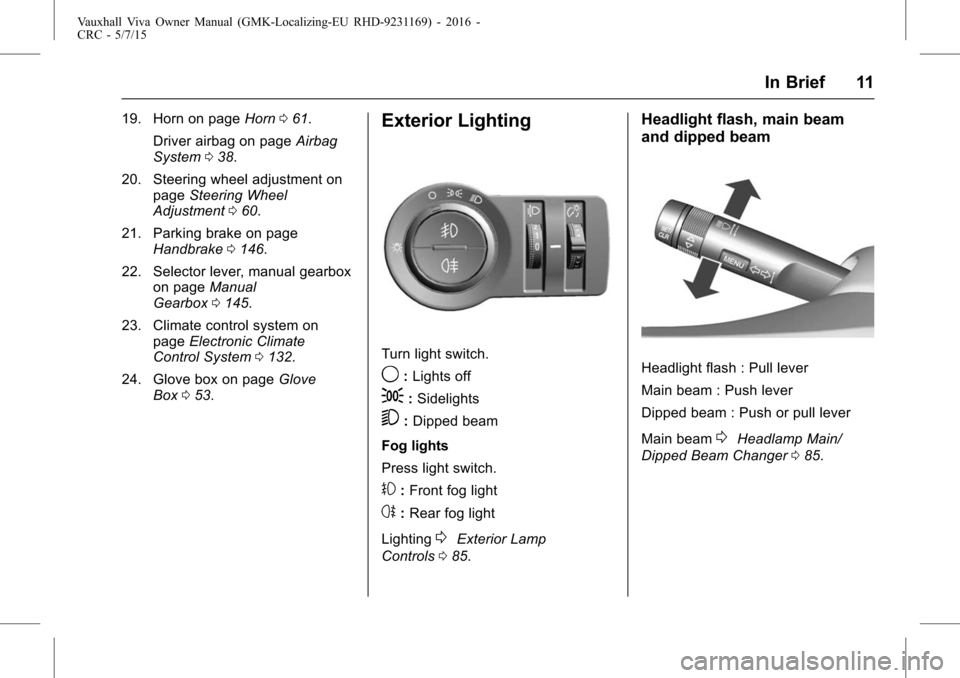
Vauxhall Viva Owner Manual (GMK-Localizing-EU RHD-9231169) - 2016 -
CRC - 5/7/15
In Brief 11
19. Horn on pageHorn061.
Driver airbag on page Airbag
System 038.
20. Steering wheel adjustment on page Steering Wheel
Adjustment 060.
21. Parking brake on page Handbrake 0146.
22. Selector lever, manual gearbox on page Manual
Gearbox 0145.
23. Climate control system on page Electronic Climate
Control System 0132.
24. Glove box on page Glove
Box 053.Exterior Lighting
Turn light switch.
9:Lights off
;:Sidelights
5:Dipped beam
Fog lights
Press light switch.
#: Front fog light
s:Rear fog light
Lighting
0Exterior Lamp
Controls 085.
Headlight flash, main beam
and dipped beam
Headlight flash : Pull lever
Main beam : Push lever
Dipped beam : Push or pull lever
Main beam
0Headlamp Main/
Dipped Beam Changer 085.
Page 16 of 222
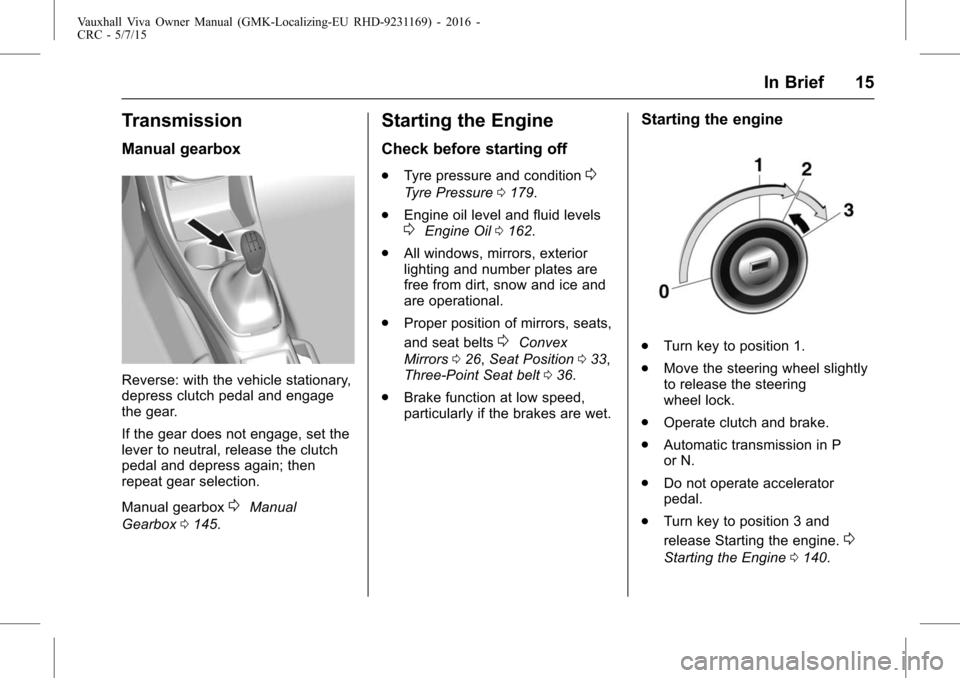
Vauxhall Viva Owner Manual (GMK-Localizing-EU RHD-9231169) - 2016 -
CRC - 5/7/15
In Brief 15
Transmission
Manual gearbox
Reverse: with the vehicle stationary,
depress clutch pedal and engage
the gear.
If the gear does not engage, set the
lever to neutral, release the clutch
pedal and depress again; then
repeat gear selection.
Manual gearbox
0Manual
Gearbox 0145.
Starting the Engine
Check before starting off
.
Tyre pressure and condition0
Tyre Pressure 0179.
. Engine oil level and fluid levels
0Engine Oil 0162.
. All windows, mirrors, exterior
lighting and number plates are
free from dirt, snow and ice and
are operational.
. Proper position of mirrors, seats,
and seat belts
0Convex
Mirrors 026, Seat Position 033,
Three-Point Seat belt 036.
. Brake function at low speed,
particularly if the brakes are wet.
Starting the engine
.
Turn key to position 1.
. Move the steering wheel slightly
to release the steering
wheel lock.
. Operate clutch and brake.
. Automatic transmission in P
or N.
. Do not operate accelerator
pedal.
. Turn key to position 3 and
release Starting the engine.
0
Starting the Engine 0140.
Page 139 of 222
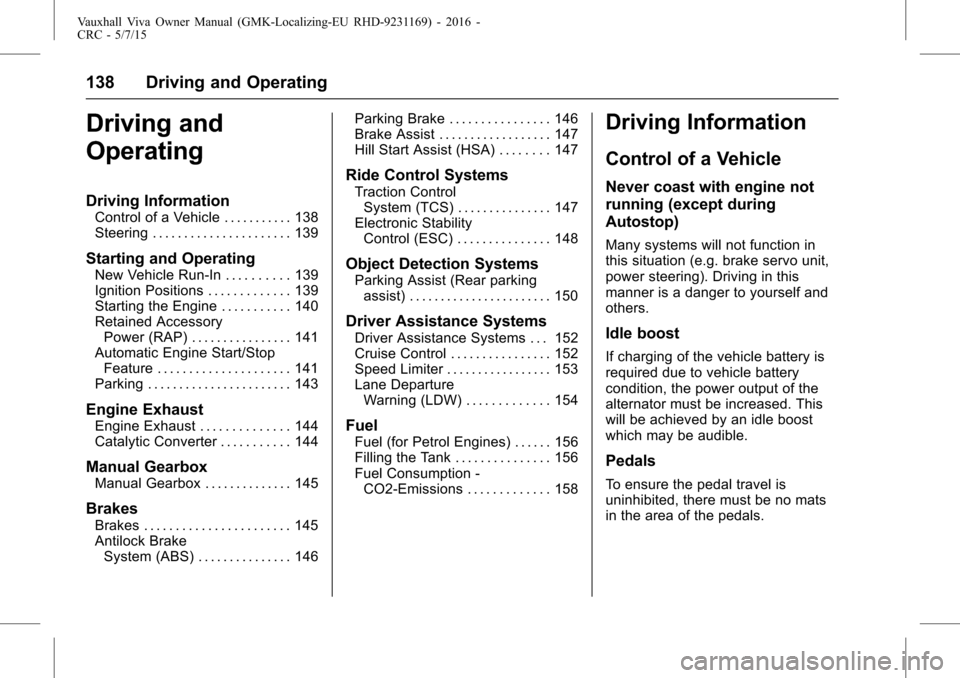
Vauxhall Viva Owner Manual (GMK-Localizing-EU RHD-9231169) - 2016 -
CRC - 5/7/15
138 Driving and Operating
Driving and
Operating
Driving Information
Control of a Vehicle . . . . . . . . . . . 138
Steering . . . . . . . . . . . . . . . . . . . . . . 139
Starting and Operating
New Vehicle Run-In . . . . . . . . . . 139
Ignition Positions . . . . . . . . . . . . . 139
Starting the Engine . . . . . . . . . . . 140
Retained AccessoryPower (RAP) . . . . . . . . . . . . . . . . 141
Automatic Engine Start/Stop Feature . . . . . . . . . . . . . . . . . . . . . 141
Parking . . . . . . . . . . . . . . . . . . . . . . . 143
Engine Exhaust
Engine Exhaust . . . . . . . . . . . . . . 144
Catalytic Converter . . . . . . . . . . . 144
Manual Gearbox
Manual Gearbox . . . . . . . . . . . . . . 145
Brakes
Brakes . . . . . . . . . . . . . . . . . . . . . . . 145
Antilock Brake System (ABS) . . . . . . . . . . . . . . . 146 Parking Brake . . . . . . . . . . . . . . . . 146
Brake Assist . . . . . . . . . . . . . . . . . . 147
Hill Start Assist (HSA) . . . . . . . . 147
Ride Control Systems
Traction Control
System (TCS) . . . . . . . . . . . . . . . 147
Electronic Stability Control (ESC) . . . . . . . . . . . . . . . 148
Object Detection Systems
Parking Assist (Rear parkingassist) . . . . . . . . . . . . . . . . . . . . . . . 150
Driver Assistance Systems
Driver Assistance Systems . . . 152
Cruise Control . . . . . . . . . . . . . . . . 152
Speed Limiter . . . . . . . . . . . . . . . . . 153
Lane DepartureWarning (LDW) . . . . . . . . . . . . . 154
Fuel
Fuel (for Petrol Engines) . . . . . . 156
Filling the Tank . . . . . . . . . . . . . . . 156
Fuel Consumption -CO2-Emissions . . . . . . . . . . . . . 158
Driving Information
Control of a Vehicle
Never coast with engine not
running (except during
Autostop)
Many systems will not function in
this situation (e.g. brake servo unit,
power steering). Driving in this
manner is a danger to yourself and
others.
Idle boost
If charging of the vehicle battery is
required due to vehicle battery
condition, the power output of the
alternator must be increased. This
will be achieved by an idle boost
which may be audible.
Pedals
To ensure the pedal travel is
uninhibited, there must be no mats
in the area of the pedals.
Page 141 of 222
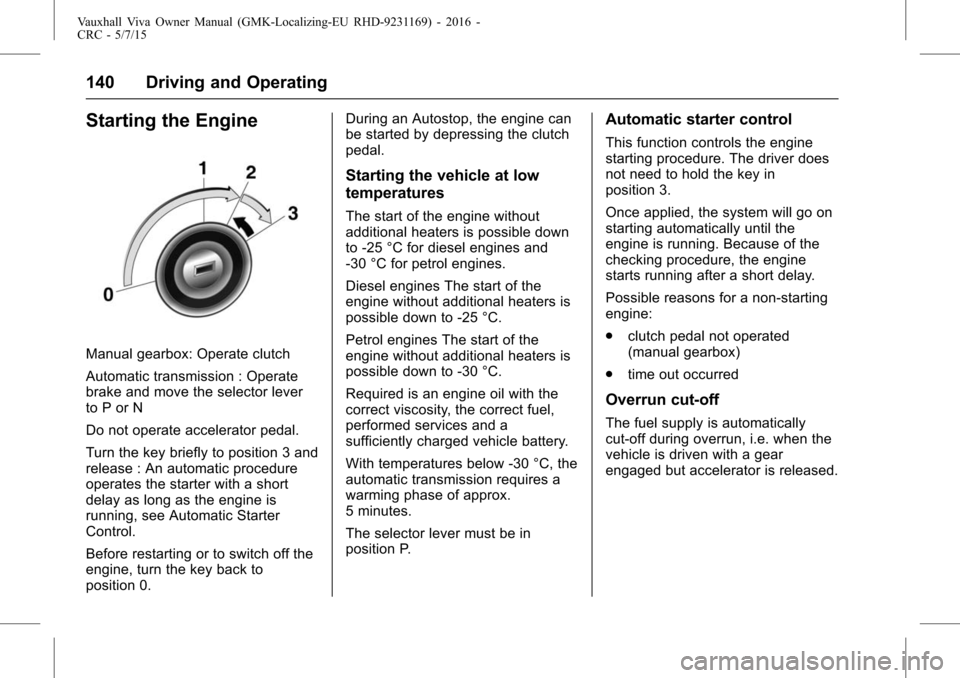
Vauxhall Viva Owner Manual (GMK-Localizing-EU RHD-9231169) - 2016 -
CRC - 5/7/15
140 Driving and Operating
Starting the Engine
Manual gearbox: Operate clutch
Automatic transmission : Operate
brake and move the selector lever
to P or N
Do not operate accelerator pedal.
Turn the key briefly to position 3 and
release : An automatic procedure
operates the starter with a short
delay as long as the engine is
running, see Automatic Starter
Control.
Before restarting or to switch off the
engine, turn the key back to
position 0.During an Autostop, the engine can
be started by depressing the clutch
pedal.
Starting the vehicle at low
temperatures
The start of the engine without
additional heaters is possible down
to -25 °C for diesel engines and
-30 °C for petrol engines.
Diesel engines The start of the
engine without additional heaters is
possible down to -25 °C.
Petrol engines The start of the
engine without additional heaters is
possible down to -30 °C.
Required is an engine oil with the
correct viscosity, the correct fuel,
performed services and a
sufficiently charged vehicle battery.
With temperatures below -30 °C, the
automatic transmission requires a
warming phase of approx.
5 minutes.
The selector lever must be in
position P.
Automatic starter control
This function controls the engine
starting procedure. The driver does
not need to hold the key in
position 3.
Once applied, the system will go on
starting automatically until the
engine is running. Because of the
checking procedure, the engine
starts running after a short delay.
Possible reasons for a non-starting
engine:
.
clutch pedal not operated
(manual gearbox)
. time out occurred
Overrun cut-off
The fuel supply is automatically
cut-off during overrun, i.e. when the
vehicle is driven with a gear
engaged but accelerator is released.
Page 146 of 222
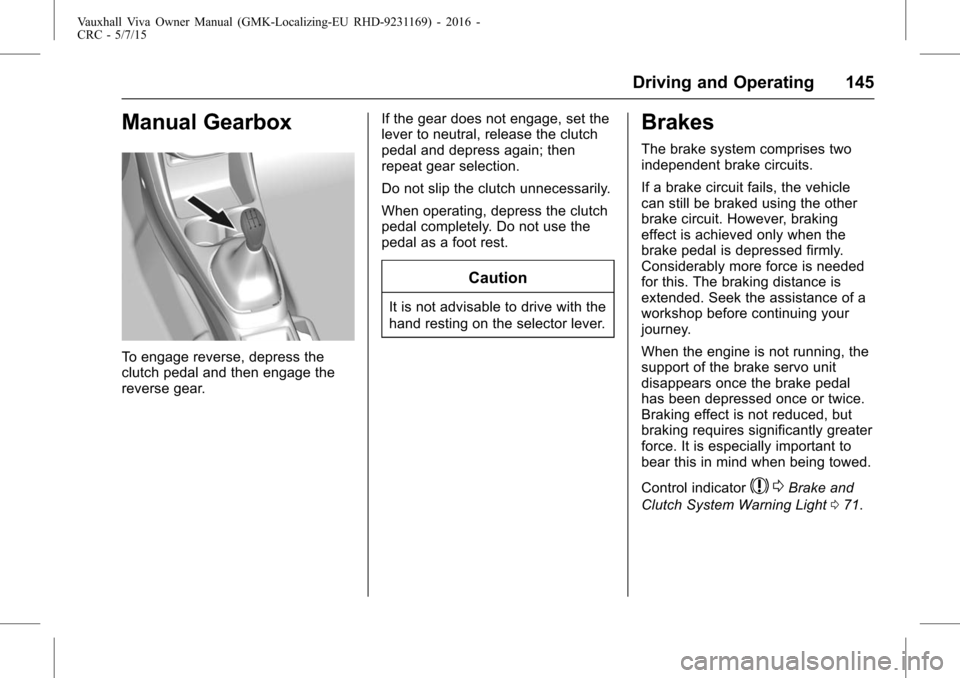
Vauxhall Viva Owner Manual (GMK-Localizing-EU RHD-9231169) - 2016 -
CRC - 5/7/15
Driving and Operating 145
Manual Gearbox
To engage reverse, depress the
clutch pedal and then engage the
reverse gear.If the gear does not engage, set the
lever to neutral, release the clutch
pedal and depress again; then
repeat gear selection.
Do not slip the clutch unnecessarily.
When operating, depress the clutch
pedal completely. Do not use the
pedal as a foot rest.
Caution
It is not advisable to drive with the
hand resting on the selector lever.
Brakes
The brake system comprises two
independent brake circuits.
If a brake circuit fails, the vehicle
can still be braked using the other
brake circuit. However, braking
effect is achieved only when the
brake pedal is depressed firmly.
Considerably more force is needed
for this. The braking distance is
extended. Seek the assistance of a
workshop before continuing your
journey.
When the engine is not running, the
support of the brake servo unit
disappears once the brake pedal
has been depressed once or twice.
Braking effect is not reduced, but
braking requires significantly greater
force. It is especially important to
bear this in mind when being towed.
Control indicator
$
0Brake and
Clutch System Warning Light 071.
Page 176 of 222
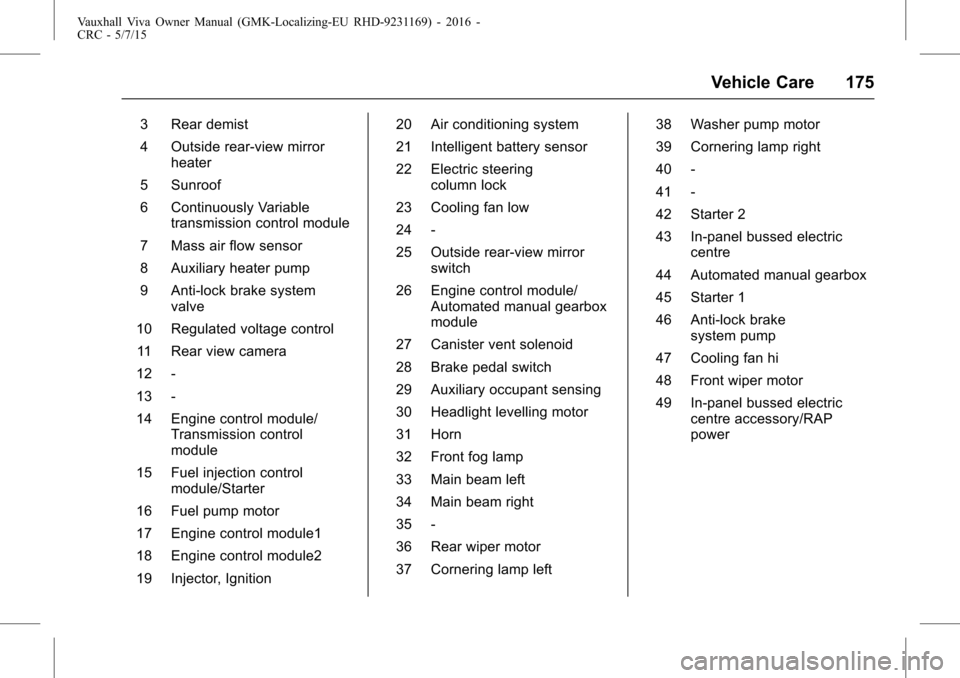
Vauxhall Viva Owner Manual (GMK-Localizing-EU RHD-9231169) - 2016 -
CRC - 5/7/15
Vehicle Care 175
3 Rear demist
4 Outside rear-view mirrorheater
5 Sunroof
6 Continuously Variable transmission control module
7 Mass air flow sensor
8 Auxiliary heater pump
9 Anti-lock brake system valve
10 Regulated voltage control 11 Rear view camera
12 -
13 -
14 Engine control module/ Transmission control
module
15 Fuel injection control module/Starter
16 Fuel pump motor
17 Engine control module1
18 Engine control module2
19 Injector, Ignition 20 Air conditioning system
21 Intelligent battery sensor
22 Electric steering
column lock
23 Cooling fan low
24 -
25 Outside rear-view mirror switch
26 Engine control module/ Automated manual gearbox
module
27 Canister vent solenoid
28 Brake pedal switch
29 Auxiliary occupant sensing
30 Headlight levelling motor
31 Horn
32 Front fog lamp
33 Main beam left
34 Main beam right
35 -
36 Rear wiper motor
37 Cornering lamp left 38 Washer pump motor
39 Cornering lamp right
40 -
41 -
42 Starter 2
43 In-panel bussed electric
centre
44 Automated manual gearbox
45 Starter 1
46 Anti-lock brake system pump
47 Cooling fan hi
48 Front wiper motor
49 In-panel bussed electric centre accessory/RAP
power
Page 178 of 222
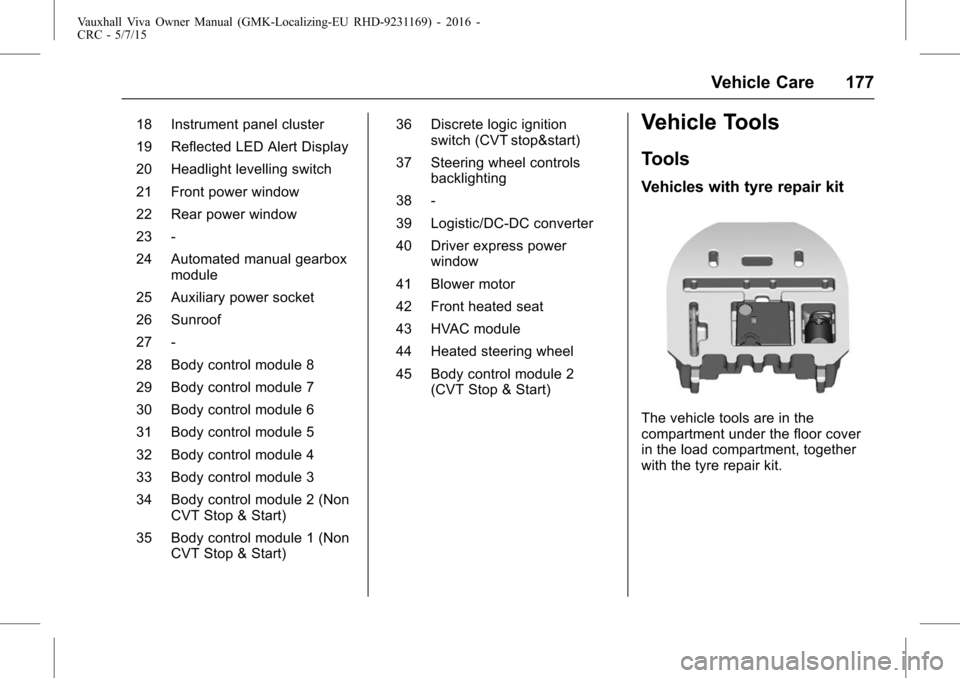
Vauxhall Viva Owner Manual (GMK-Localizing-EU RHD-9231169) - 2016 -
CRC - 5/7/15
Vehicle Care 177
18 Instrument panel cluster
19 Reflected LED Alert Display
20 Headlight levelling switch
21 Front power window
22 Rear power window
23 -
24 Automated manual gearboxmodule
25 Auxiliary power socket
26 Sunroof
27 -
28 Body control module 8
29 Body control module 7
30 Body control module 6
31 Body control module 5
32 Body control module 4
33 Body control module 3
34 Body control module 2 (Non CVT Stop & Start)
35 Body control module 1 (Non CVT Stop & Start) 36 Discrete logic ignition
switch (CVT stop&start)
37 Steering wheel controls backlighting
38 -
39 Logistic/DC-DC converter
40 Driver express power window
41 Blower motor
42 Front heated seat
43 HVAC module
44 Heated steering wheel
45 Body control module 2 (CVT Stop & Start)Vehicle Tools
Tools
Vehicles with tyre repair kit
The vehicle tools are in the
compartment under the floor cover
in the load compartment, together
with the tyre repair kit.
Page 186 of 222
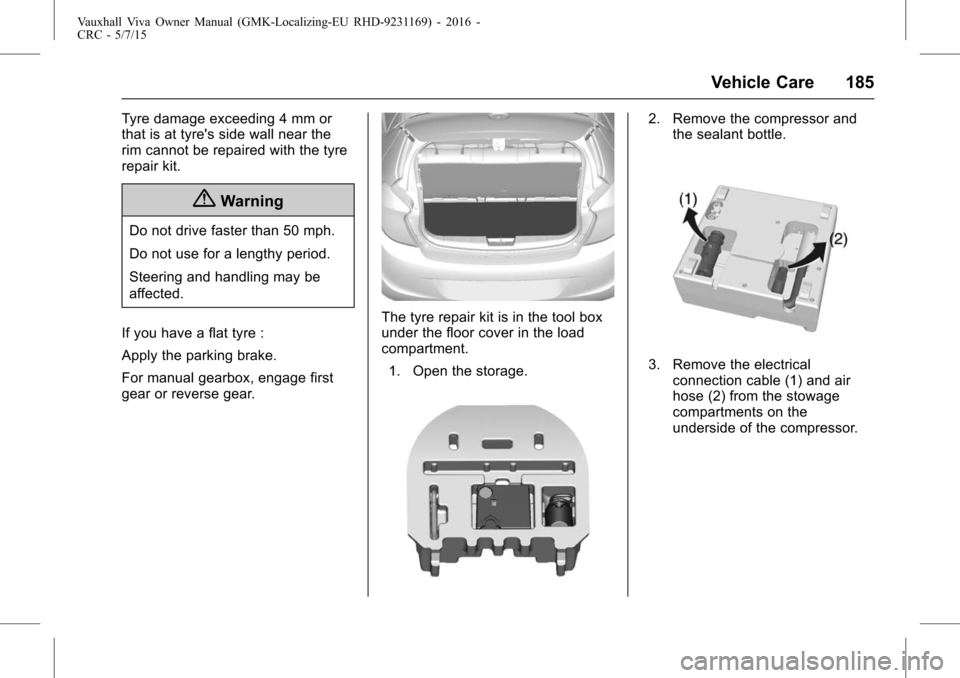
Vauxhall Viva Owner Manual (GMK-Localizing-EU RHD-9231169) - 2016 -
CRC - 5/7/15
Vehicle Care 185
Tyre damage exceeding 4 mm or
that is at tyre's side wall near the
rim cannot be repaired with the tyre
repair kit.
{Warning
Do not drive faster than 50 mph.
Do not use for a lengthy period.
Steering and handling may be
affected.
If you have a flat tyre :
Apply the parking brake.
For manual gearbox, engage first
gear or reverse gear.
The tyre repair kit is in the tool box
under the floor cover in the load
compartment. 1. Open the storage.
2. Remove the compressor and the sealant bottle.
3. Remove the electricalconnection cable (1) and air
hose (2) from the stowage
compartments on the
underside of the compressor.
Page 189 of 222
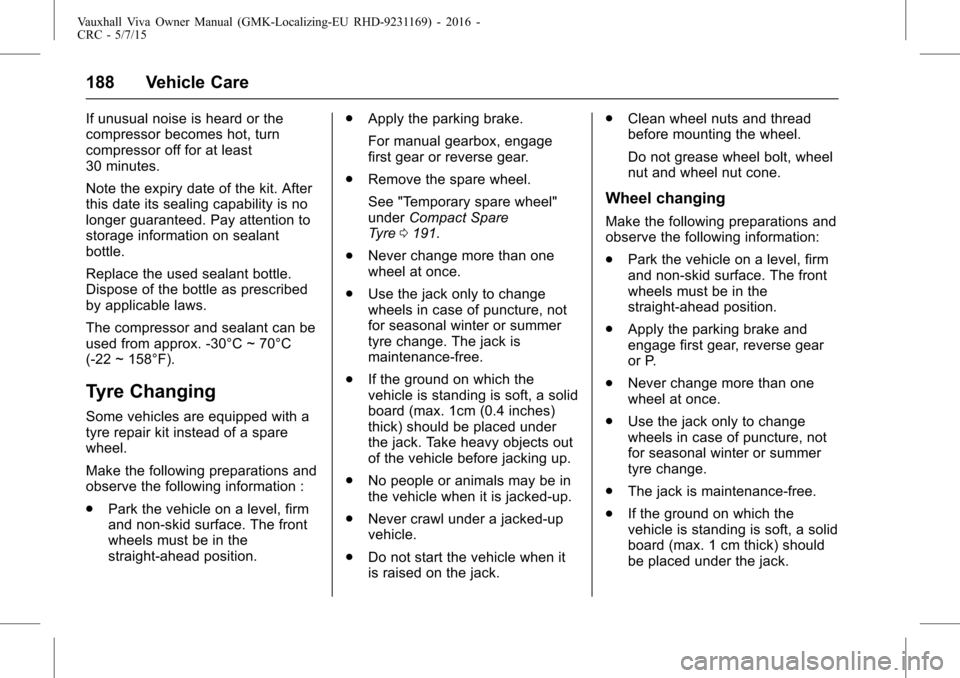
Vauxhall Viva Owner Manual (GMK-Localizing-EU RHD-9231169) - 2016 -
CRC - 5/7/15
188 Vehicle Care
If unusual noise is heard or the
compressor becomes hot, turn
compressor off for at least
30 minutes.
Note the expiry date of the kit. After
this date its sealing capability is no
longer guaranteed. Pay attention to
storage information on sealant
bottle.
Replace the used sealant bottle.
Dispose of the bottle as prescribed
by applicable laws.
The compressor and sealant can be
used from approx. -30°C ~ 70°C
(-22 ~ 158°F).
Tyre Changing
Some vehicles are equipped with a
tyre repair kit instead of a spare
wheel.
Make the following preparations and
observe the following information :
.Park the vehicle on a level, firm
and non-skid surface. The front
wheels must be in the
straight-ahead position. .
Apply the parking brake.
For manual gearbox, engage
first gear or reverse gear.
. Remove the spare wheel.
See "Temporary spare wheel"
under Compact Spare
Tyre 0191.
. Never change more than one
wheel at once.
. Use the jack only to change
wheels in case of puncture, not
for seasonal winter or summer
tyre change. The jack is
maintenance-free.
. If the ground on which the
vehicle is standing is soft, a solid
board (max. 1cm (0.4 inches)
thick) should be placed under
the jack. Take heavy objects out
of the vehicle before jacking up.
. No people or animals may be in
the vehicle when it is jacked-up.
. Never crawl under a jacked-up
vehicle.
. Do not start the vehicle when it
is raised on the jack. .
Clean wheel nuts and thread
before mounting the wheel.
Do not grease wheel bolt, wheel
nut and wheel nut cone.
Wheel changing
Make the following preparations and
observe the following information:
.Park the vehicle on a level, firm
and non-skid surface. The front
wheels must be in the
straight-ahead position.
. Apply the parking brake and
engage first gear, reverse gear
or P.
. Never change more than one
wheel at once.
. Use the jack only to change
wheels in case of puncture, not
for seasonal winter or summer
tyre change.
. The jack is maintenance-free.
. If the ground on which the
vehicle is standing is soft, a solid
board (max. 1 cm thick) should
be placed under the jack.
Page 194 of 222
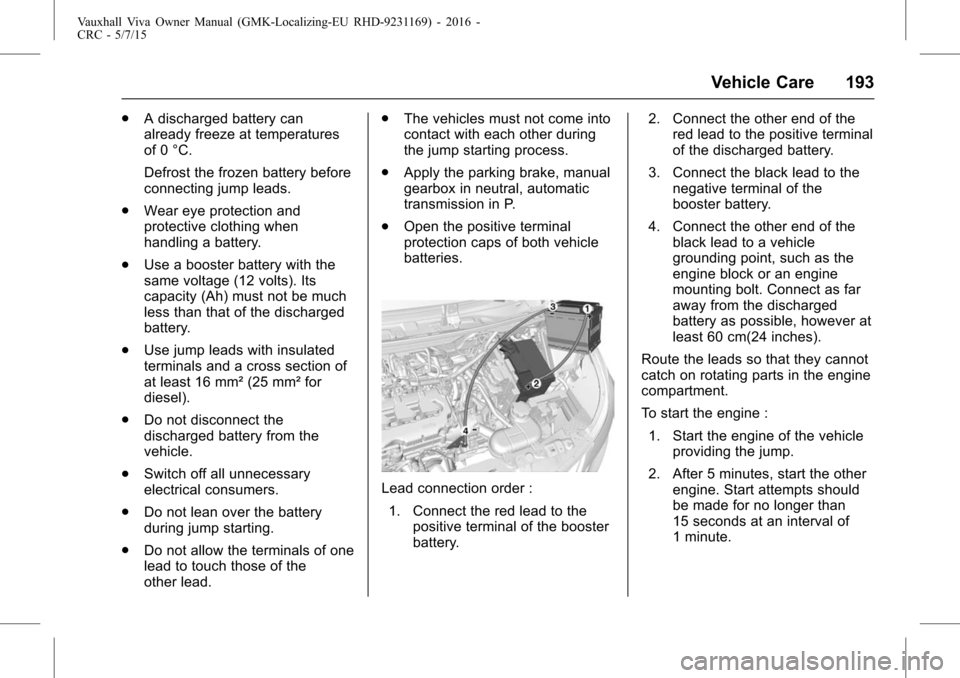
Vauxhall Viva Owner Manual (GMK-Localizing-EU RHD-9231169) - 2016 -
CRC - 5/7/15
Vehicle Care 193
.A discharged battery can
already freeze at temperatures
of 0 °C.
Defrost the frozen battery before
connecting jump leads.
. Wear eye protection and
protective clothing when
handling a battery.
. Use a booster battery with the
same voltage (12 volts). Its
capacity (Ah) must not be much
less than that of the discharged
battery.
. Use jump leads with insulated
terminals and a cross section of
at least 16 mm² (25 mm² for
diesel).
. Do not disconnect the
discharged battery from the
vehicle.
. Switch off all unnecessary
electrical consumers.
. Do not lean over the battery
during jump starting.
. Do not allow the terminals of one
lead to touch those of the
other lead. .
The vehicles must not come into
contact with each other during
the jump starting process.
. Apply the parking brake, manual
gearbox in neutral, automatic
transmission in P.
. Open the positive terminal
protection caps of both vehicle
batteries.
Lead connection order :
1. Connect the red lead to the positive terminal of the booster
battery. 2. Connect the other end of the
red lead to the positive terminal
of the discharged battery.
3. Connect the black lead to the negative terminal of the
booster battery.
4. Connect the other end of the black lead to a vehicle
grounding point, such as the
engine block or an engine
mounting bolt. Connect as far
away from the discharged
battery as possible, however at
least 60 cm(24 inches).
Route the leads so that they cannot
catch on rotating parts in the engine
compartment.
To start the engine : 1. Start the engine of the vehicle providing the jump.
2. After 5 minutes, start the other engine. Start attempts should
be made for no longer than
15 seconds at an interval of
1 minute.